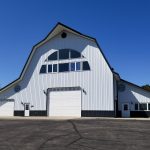Welcome to Ask the Pole Barn Guru – where you can ask questions about building topics, with answers posted on Mondays. With many questions to answer, please be patient to watch for yours to come up on a future Monday segment. If you want a quick answer, please be sure to answer with a “reply-able” email address.
Email all questions to: PoleBarnGuru@HansenPoleBuildings.com
DEAR POLE BARN GURU: Hello, The bottom of my 2 x 8 skirt board is about 2 inches into the ground. Is it OK to measure 10 feet from the top of the skirt board since it is so low?
As long as the steel siding is long enough I would like to do this. If I measure from the bottom of the skirt board and add my 3 1/2 inch. of cement then my ceiling is lower. I can add another skirt board on top of the one that is there. I can add dirt up against the outsides so it looks OK
I hope to work on this in the morning so please answer as soon as possible.
SITTING IN SALEM
DEAR SITTING: You could do as you suggest (measuring the 10′ from the top of the 2×8 skirt board), as long as you add another 2×8 skirt board on top of the one you have installed, then fill up to the top of the lower 2×8 skirt board before pouring your concrete floor.
All of the steel for the siding is pre-cut to fit based upon a 0 point being the bottom of the 2×8 skirt board. There is no way to increase your interior height without ordering new wall steel or adding wainscot – either of which will prove to be a significant expense to pick up a few inches of height.
Mike the Pole Barn Guru
DEAR POLE BARN GURU: I have a pole barn that I am insulating. I am using rigid foam on ceiling between truss chords, covered with steel. Walls are 4×6 poles with 2×4 purlins on outside, sided with steel. I am adding 2×6 vertical studs on 24″ centers between poles, and stapling craft-backed roll f-glass insulation to studs, then covering wall with OSB. Should I consider stapling tar paper or other barrier to inside of purlins before adding the studs and insulation? There will be an air gap between the f-glass insulation and the outer steel, and moisture can get in via corrugations in the steel siding, top and bottom. Thanks! BUILDING IN BELLEVILLE
DEAR BUILDING: You should place a housewrap (think Tyvek) ideally between the wall girts and the siding, but if not there, on the inside of the wall girts.
You can read more about housewrap here: https://www.hansenpolebuildings.com/blog/2012/11/house-wrap/
Here are some hints as to how to minimize the cost of your framing to support the insulation, and reduce transference of cold/heat from the contact of 2×6 vertical studs with the exterior horizontal girts.
- Start by placing a pressure treated 2×4 on top of the slab, flush to the inside of the columns (this board will end up between the posts, as will subsequent ones).
- Cut 2×4 blocks to 22-7/16″ and nail one to the each post directly above the treated 2×4.
- Cut a 2×4 to fit between the posts, and place like a bookshelf on top of the blocks. Repeat this process throughout the building.For best energy efficiency, make sure to completely seal the facing of the insulation batts on the inside of the wall.
Mike the Pole Barn Guru
DEAR POLE BARN GURU: Hello, I purchased my Hansen Pole Building some time ago. I’m just now getting around to drywall, but have always been stumped with one part of the construction. How are you supposed to attach the drywall “L” top plate? (I have the commercial girt setup). There just isn’t anything to attach the top plates unless I’m toe nailing it to the posts which doesn’t seem correct to me. The girts were attached to girt blocks, but the “L” top plate doesn’t have anything like that. Like I said…this one has stumped me for some time and now that I’m getting around to drywall I need to get the top plate installed.
Thank you very much, HARRIED IN HARRISVILLE
DEAR HARRIED: The distance from center to center of your wall columns is 12’. Conservatively, the “L” supports a maximum of 12 square feet (1/2 of the distance to the first ceiling joist, which is at 24 inches on center). 5/8” gypsum wallboard weighs 2.31 pounds per square foot. This makes the weight supported by the “L” of just under 28 pounds.
The 2005 NDS® (National Design Specification® for Wood Construction published by the American Forest & Paper Association) addresses toe nailing connections in “Design Aid No. 2”. To keep the design conservative, we will use the lowest Specific Gravity value of the commonly used framing lumbers (G=0.42 for Spruce-Pine-Fir). With the specified 10d common nail (3 inch length x 0.148 inch diameter), the lateral design value for a toe-nailed connection is 83 pounds per nail.
Placing two toe-nails through each end of the vertical member of the “L” would allow the “L” to support up to 332 pounds, many times the needed design requirements.
If you are uncomfortable with toe nailing the “L”, you could cut a notch out of the top “flat” part of the “L” 1-1/2 inches deep, to fit it tightly to the face of the column above the ceiling line. Two 10d common nails could be driven through the remaining portion of the “flat” of the “L” into the column, in addition to toe nailing them.
Mike the Pole Barn Guru








